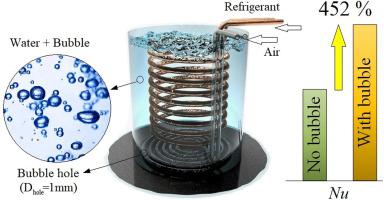Applied Thermal Engineering ( IF 6.1 ) Pub Date : 2021-09-20 , DOI: 10.1016/j.applthermaleng.2021.117559 Ahmad Zarei 1 , Sadegh Seddighi 1, 2 , Sohail Elahi 1 , Ramis Örlü 3

|
This study investigates cold thermal energy storage (CTES) using a helical coil heat exchanger modified with bubble injection. One of the effective methods for increasing the heat transfer rate in heat exchangers is using bubble injection. A helical coil heat exchanger is immersed inside a cylindrical water storage tank, where the helical coil is the evaporator of a vapor compression refrigeration cycle (VCRC) and provides the designed cooling. Experimental studies were carried out to examine the impact of bubble injection on Nusselt number, the temperature differences in the storage tank, exergy degradation in the evaporator, and cycle coefficient of performance (COP). The bubbles were injected from the bottom of the storage tank in four different geometries at airflow rates ranging from 3 to 11 L/min. The experimental results of this study revealed that bubble injection could significantly increase the COP and heat transfer rate from the storage tank, as well as the exergy destruction and Nusselt number (Nu). This increase was highly dependent on the geometry and flow rate of the bubble injection. The results also indicated that the bubble injection has an optimal flow rate value, which was 9 L/min in this study. More specifically, the COP of the refrigeration cycle and the Nu number increased by 124% and 452%, respectively, compared to the non-bubble injection mode. Finally, for calculating the outside Nusselt number of the helical coil, an empirical correlation as a function of bubble flow rate and bubble injection angle was proposed.
中文翻译:

冷热蓄能系统气泡注入螺旋盘管换热器传热实验研究
本研究使用气泡注入改进的螺旋盘管换热器研究冷热能储存 ( CTES )。提高换热器传热率的有效方法之一是使用气泡注入。螺旋盘管换热器浸入圆柱形储水箱内,其中螺旋盘管是蒸汽压缩制冷循环 ( VCRC )的蒸发器,并提供设计的冷却。进行了实验研究以检查气泡注入对努塞尔数、储罐中的温差、蒸发器中的火用退化和循环性能系数 ( COP) 的影响)。气泡从储罐底部以四种不同的几何形状以 3 到 11 L/min 的气流速率注入。本研究的实验结果表明,气泡注入可以显着提高储罐的 COP 和传热率,以及火用破坏和努塞尔数 ( Nu )。这种增加高度依赖于气泡注射的几何形状和流速。结果还表明,气泡注入具有最佳流速值,在本研究中为 9 L/min。更具体地说,制冷循环的COP和Nu与无气泡注入模式相比,数量分别增加了 124% 和 452%。最后,为了计算螺旋线圈的外努塞尔数,提出了作为气泡流速和气泡喷射角函数的经验相关性。











































 京公网安备 11010802027423号
京公网安备 11010802027423号